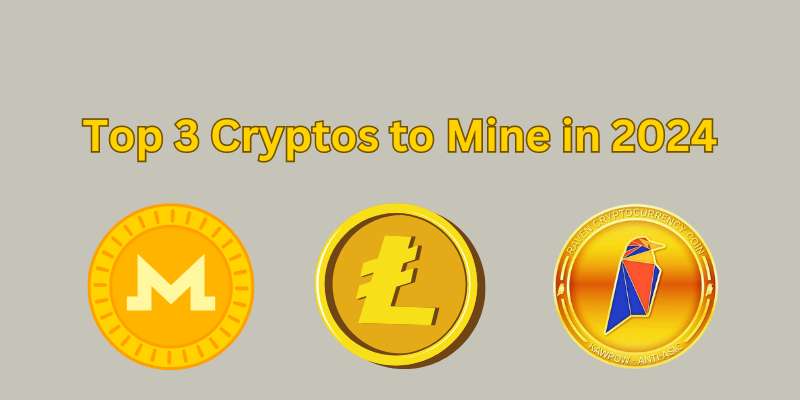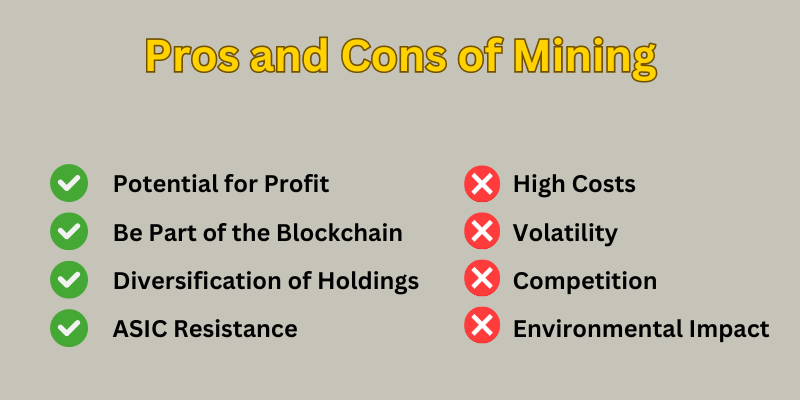Mining cryptocurrency involves using computer hardware to solve complex mathematical puzzles, verifying transactions on the blockchain network, and securing the network.
Miners are rewarded with new coins for their efforts. It’s like digging for digital gold by processing transactions and maintaining the integrity of the cryptocurrency system.
In this article, we talk about the three best cryptos for mining and explain the main mining pors and cons.
Top 3 Cryptos to Mine in 2024
Below, find the description of three best cryptos for mining.
Monero (XMR)
Monero (XMR) stands out as a privacy-focused contender. It is mineable and specifically designed to resist mining with Application-Specific Integrated Circuits (ASICs), allowing for more decentralized mining using standard CPUs.
Monero prioritizes privacy and security, with transactions on its blockchain to make tracking the origin and destination of funds difficult.
Features like ring signatures and ring confidential transactions furtherimprove anonymity.
For miners, Monero’s profitability varies, but its ASIC-resistant nature opens opportunities for CPU mining. Joining a Monero mining pool is advisable due to the high network difficulty.

Litecoin (LTC)
Litecoin (LTC) is often referred to as “the silver to Bitcoin’s gold”, best cryptocurrency to mine. It is mineable with the Scrypt algorithm, originally ASIC-resistant but now efficiently mined with GPUs.
Litecoin aims to be a faster and more scalable alternative to Bitcoin, offering quicker transaction confirmation times and a larger total supply of coins.
Mining profitability depends on factors like electricity costs, hardware efficiency, and mining pool fees.
GPUs are the preferred hardware for Litecoin mining, and joining a mining pool is recommended due to network difficulty.
Ravencoin (RVN)
Ravencoin (RVN) is known for its asset-oriented approach. It is mineable with the KawPow algorithm, designed to be ASIC-resistant and suitable for GPU mining.
Ravencoin’s focus is on creating a blockchain for issuing and managing assets, allowing users to create custom tokens.
Mining profitability for Ravencoin can fluctuate based on market conditions and network difficulty.
GPUs are the most efficient hardware option for Ravencoin mining, and joining a mining pool is advisable for individual miners due to network difficulty.
Here’s a table summarizing the key points for comparison:
| Feature | Monero (XMR) | Litecoin (LTC) | Ravencoin (RVN) |
| Mineable | Yes (ASIC-resistant) | Yes (limited) | Yes (ASIC-resistant) |
| Algorithm | RandomX | Scrypt | KawPow |
| Functionality | Privacy-focused | Faster Bitcoin alternative | Asset issuance |
| Profitability | Varies | Varies | Varies |
| Mining Hardware | CPU | GPU | GPU |
| Mining Pools | Recommended | Recommended | Recommended |
Pros and Cons of Mining
Mining cryptocurrency can be a tempting way to potentially earn rewards, but it’s not without its challenges.
First, you can explore the pros and cons of cryptocurrency. Here’s a breakdown of the pros and cons of mining to help you decide if mining is right for you:
Pros
- Potential for Profit. If done correctly, mining can be a profitable way to earn cryptocurrency. The potential rewards can be significant, especially for early adopters who mine coins with lower network difficulty.
- Be Part of the Blockchain. Miners are important in securing the blockchain network by verifying transactions. You’ll be contributing to the decentralized nature of cryptocurrency.
- Diversification of Holdings. Mining allows you to earn new coins without having to purchase them directly on an exchange. This can be a good way to diversify your cryptocurrency portfolio.
- ASIC Resistance (for some coins). Certain coins, like Monero and Ravencoin, use ASIC-resistant algorithms that allow for mining with standard CPUs or GPUs, making them more accessible to individual miners.

Cons
- High Costs. Setting up a mining rig can be expensive. You’ll need to factor in the cost of hardware (CPUs, GPUs, or ASICs), electricity consumption, and ongoing maintenance.
- Volatility. The value of cryptocurrency can change significantly. There’s no guarantee that the coins you mine will retain their value or even increase in price.
- Competition. The mining landscape is becoming increasingly competitive. The more miners join a network, the harder it becomes to earn rewards.
- Environmental Impact. Cryptocurrency mining can consume a significant amount of energy, especially for coins mined with ASICs. This raises concerns about its environmental impact.
Ultimately, the decision to mine cryptocurrency depends on your individual circumstances and risk tolerance.
Carefully weigh the pros and cons, conduct thorough research on the specific coin you want to mine, and consider seeking professional financial advice before investing in mining equipment or services.
Conclusion – What is the Best Cryptocurrency to Mine?
Monero (XMR) focuses on privacy, allowing people to mine it using regular computers with its unique algorithm.
Litecoin (LTC) is like a faster version of Bitcoin, and you can mine it using powerful graphics cards. Ravencoin (RVN) is all about creating and managing digital assets, and you can mine it with graphics cards too.
Each has its benefits, like Monero’s privacy, Litecoin’s speed, and Ravencoin’s asset creation.Also you can read more about the free crypto mining apps for Android.
How much you earn from mining depends on things like how efficient your hardware is and how hard it is to mine at the time. It’s often better to join a mining group because it’s easier.
FAQs: What is the Best Cryptocurrency to Mine?
What is cryptocurrency mining❓
It’s the process of validating transactions on a blockchain network and getting rewarded with coins.
What factors should I consider when choosing a cryptocurrency to mine❓
Think about hardware requirements, energy use, profitability, and the coin’s potential.
Which cryptocurrency is best to mine❓
Options include Bitcoin, Ethereum, Litecoin, and Monero, depending on market conditions and equipment.
How can I determine profitability❓
Use online calculators considering market value, difficulty, and electricity costs.
What equipment do I need for mining❓
Specialized hardware like ASIC miners or GPUs, depending on the coin.
How do I start mining❓
Set up hardware, install software, and join a pool or mine solo.
Can I mine cryptocurrencies with my computer❓
Some coins can be mined with a regular computer, but specialized hardware is usually needed for profitable mining.
Is cryptocurrency mining profitable❓
It can be, but profitability depends on many factors and can fluctuate.
Are there any risks associated with mining❓
Risks include hardware failure, market volatility, and regulatory changes.
Is mining environmentally friendly❓
It can consume a lot of energy, so some coins are working on more eco-friendly solutions.